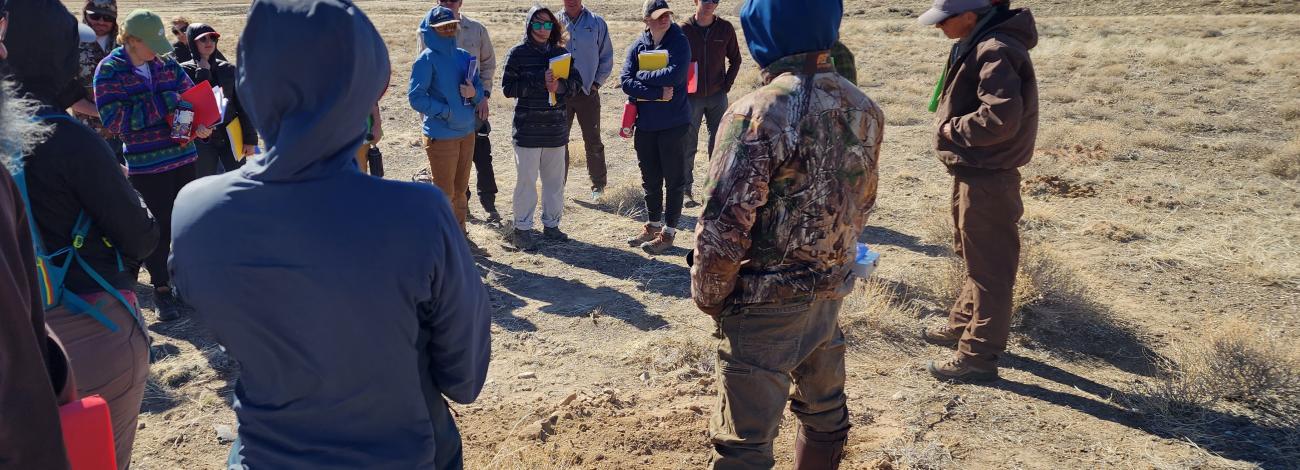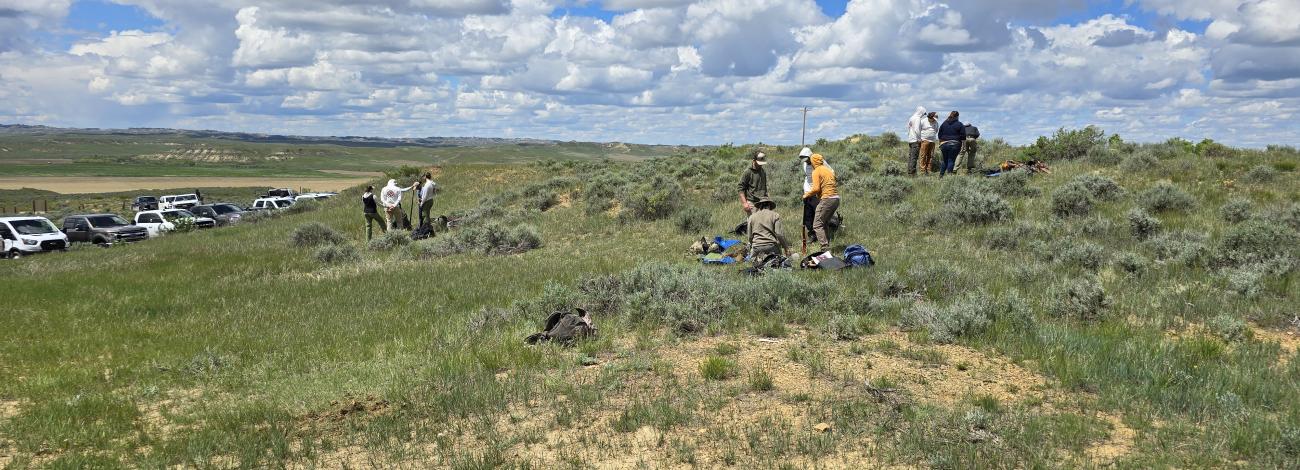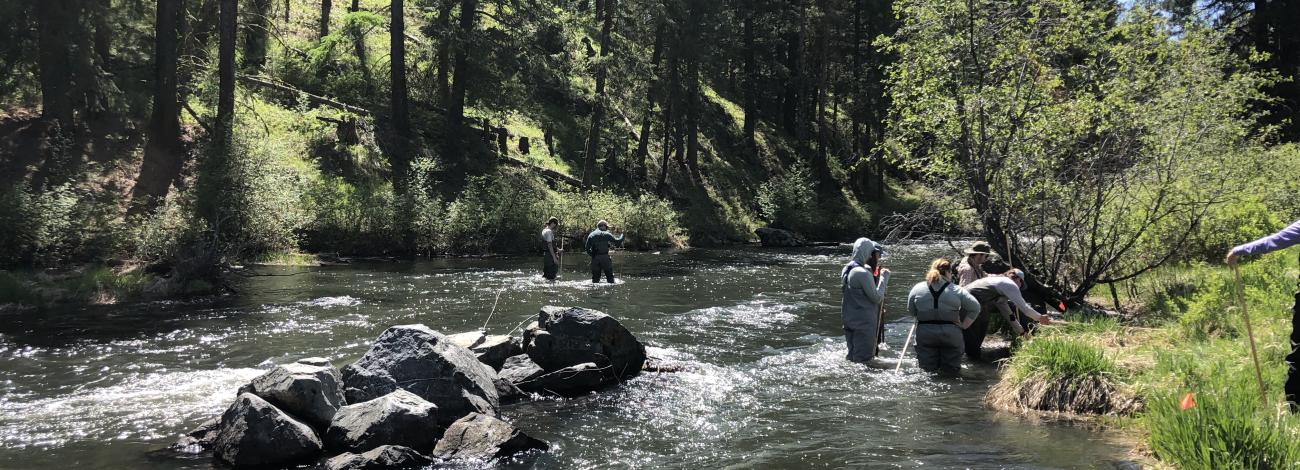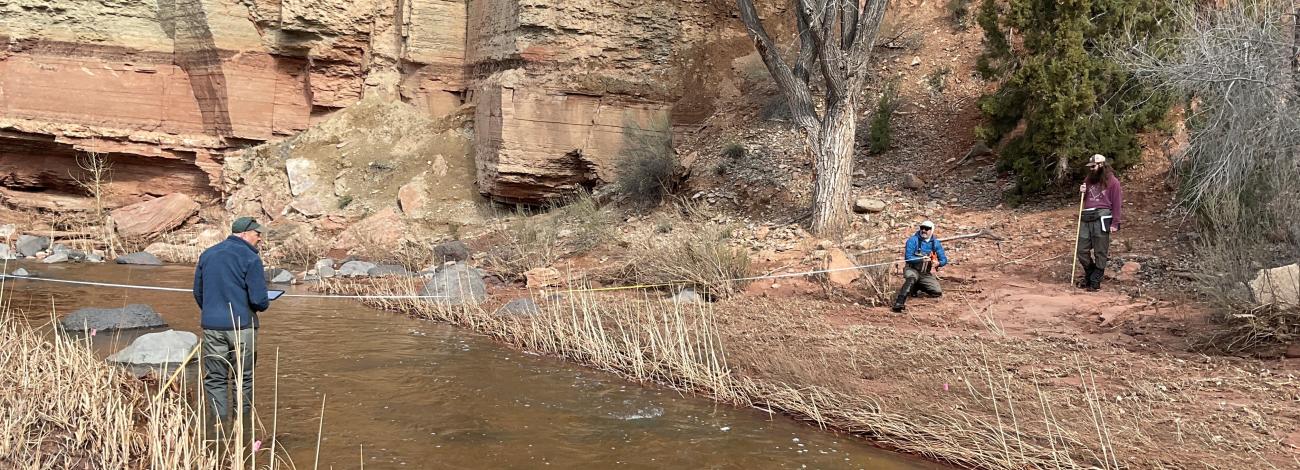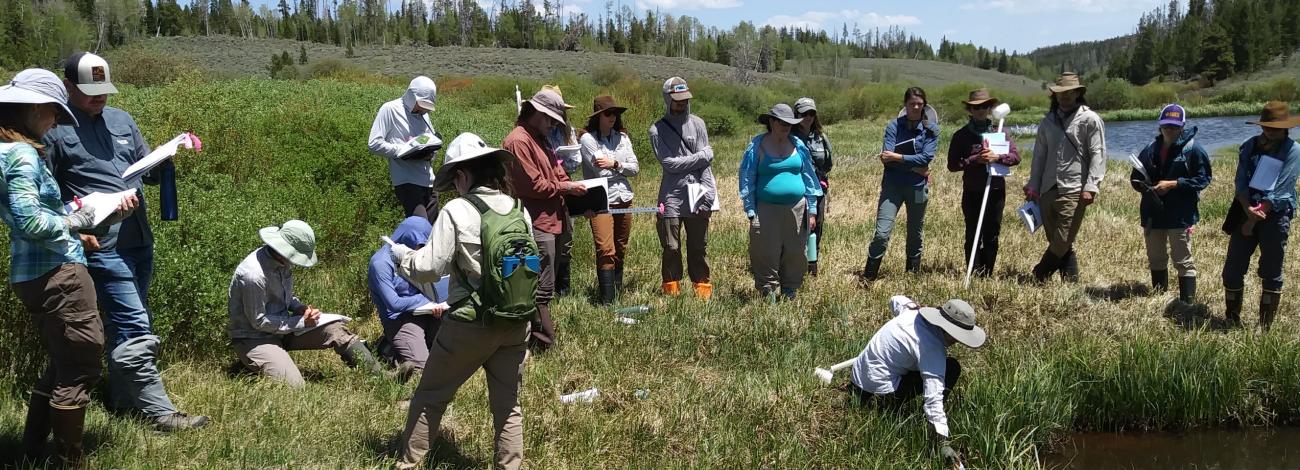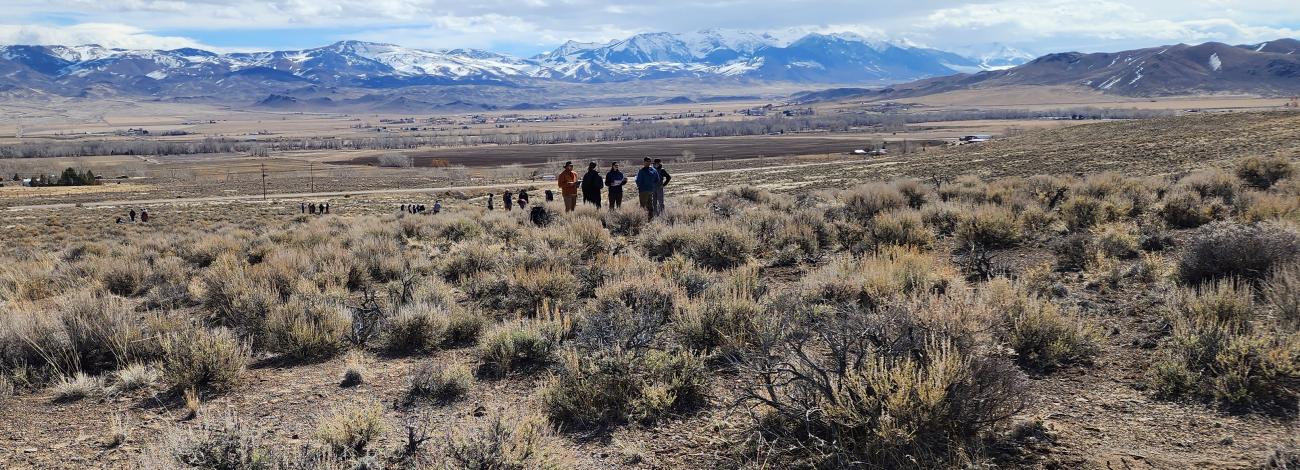
AIM Training
The BLM requires field crews to attend approved AIM protocol trainings for data to be ingested into national AIM databases. Project managers should ensure that field crews receive proper training in the core methods.
Training opportunities are available for state, district and field office monitoring leads as well. Topics include monitoring project management and applying information to decision-making.
- Resource Neutral Trainings
-
Project Leads
Project Leads training currently occurs twice a year (January and October) and is held virtually. This three-day course is open to current and potential BLM, DOI Project Leads, as well as currently-contracted Data Specialists.
November Project Leads Virtual Training 2025
Date: November 18, 19, and 20, for 2025
January Project Leads Virtual Training 2026 TBD
Date: January 28, 29 and 30, for 2025. (old dates not for upcoming 2026)
Register through DOI Talent here Project Leads Registration
Analysis and Reporting
Analysis and Reporting Trainings are currently in development.
- Terrestrial (Uplands) Trainings
-
Terrestrial Core Methods Trainings
These annual field courses are designed to train all AIM data collectors in the Terrestrial Core Methods used to gather data in the field. Trainings include protocol instruction, supervised practice, and calibration. They also provide an opportunity to practice with an electronic data capture device.
Training Requirements:
All Terrestrial AIM training attendees must complete the required online training materials before attending the field methods training.
Seasonal BLM data collectors or contractor/agreement staff responsible for Terrestrial AIM data collection must have successfully completed Terrestrial AIM Core methods training during the year in which data will be collected.
- In rare circumstances, staff responsible for Terrestrial AIM data collection will be hired after all of the trainings have been concluded. All data collectors must be trained before collecting and submitting Terrestrial AIM data. Contract/agreement managers, or BLM supervisors for BLM seasonals, must communicate all staff changes throughout the field season with the appropriate State Monitoring Coordinator and the National Terrestrial AIM team so that contingent training options can be identified.
Contractor/agreement staff not collecting Terrestrial AIM data directly, but responsible for Terrestrial AIM crew management and data QA & data QC should attend training at minimum every other year.
BLM staff collecting Terrestrial AIM data should have successfully completed a Terrestrial AIM Core Methods or Train the Trainer training within the last three years.Trainings Registration:
Training consists of a VIRTUAL instructor led portion and an IN-PERSON Field Methods portion. Dates listed on DOI Talent are for the In-Person Field Methods section. Each Core Methods Training will have ~ 8 hours of Virtual Instructor lead training prior to the In-Person Field Training.
Internal DOI registration link: https://doitalent.ibc.doi.gov/course/view.php?id=18212
External registration link: https://edoiu.doi.gov/course/view.php?id=159Pre-Course Work (Pre-requirement through DOI Talent registration in order to register)
Participants of the Terrestrial AIM Core Methods Training are required to complete ~3 hours of pre-coursework before they will be allowed to register for training. This pre-coursework is a prerequisite in DOI Talent to enroll in the AIM Terrestrial Core Methods. You must complete this before DOI Talent allows you to select a Core Methods training location.
Training Dates and Locations
Virtual Trainings will be ~ 8 hours (4 hours/day) and will be held in a virtual classroom via Zoom or Microsoft Teams. Attendance is required at both the virtual and in-person training portions to receive credit for attendance. DOI Talent Registration dates apply to the In-Person training only. Registrants for the In-Person training will be enrolled in the virtual portion as well. Please reach out to your AIM State Lead to confirm enrollment.
Terrestrial Trainings for 2025 have been concluded the table below reflects previous years training. Updated 2026 training dates will begin populating in the start of 2026.
Feb/March April May Las Cruces, NM
Virtual 1/31 (all day)
In-Person 2/4-2/7
----------------------Phoenix, AZ
Virtual 2/27-2/28
In-Person 3/4-3/7
----------------------
Cedar City, UT
Virtual 4/3-4/4
In-Person 4/8-4/11
------------------
Twin Falls, ID
Virtual 4/17-4/18
In-Person 4/21-4/25
------------------
Prineville, OR
Virtual 4/17-4/18
In-Person
4/22-4/25
-------------------
Carson City, NV
Virtual 4/17-4/18
In-Person
4/22-4/25
-------------------
Montrose, CO
Virtual 4/24-4/25
In-Person
4/29-5/2
Worland, WY
Virtual 5/1-5/2
In-Person 5/5-5/9
------------------
Santa Fe, NM
Virtual 5/1-5/2
In-Person 5/5-5/9
------------------
Salmon, ID
Virtual 5/15-5/16
In-Person
5/19-5/23
------------------
Glasgow, MT
Virtual 5/15-5/16
In-Person
5/19-5/23
Pre-course work (DO THROUGH DOI TALENT IF YOU ARE REGISTERING FOR THE COURSE)
- First, read and review the Monitoring Manual for Grassland, Shrubland, and Savanna Ecosystems SECOND EDITION.
- Second, watch the following videos on the Landscape Toolbox YouTube channel. (90 minutes total)
- Third, after viewing the videos below, please complete the pre-course quiz on the methods found here
- Intro (3:28 min)
- Ecological Site Identification (12:30 min)
- Photo Points (6:40 min)
- Establishing a Transect (6:01 min)
- Line-Point Intercept Method (18:50 min)
- Vegetation Height (8:06 min)
- Canopy Gap Intercept Method (15:35 min)
- Plant Species Inventory (4:02 min)
- Soil Stability (16:18 min)
Keep in mind that these methods are used in a variety of different rangeland monitoring programs and in research across the world, so some details might be different than those of the AIM program (for example plot layout, subsurface soil stability samples etc.). Be proactive in your understanding of the protocol by watching the videos in conjunction with reading/reviewing the manual, and maintaining active communication with your project lead or other relevant point of contact (POC).
Terrestrial Core Methods Training Presentation Videos (Please Note some links are in progress of being updated and will be unavailable):
- Intro to AIM Part 1
- Intro to AIM Part 2
- Implementing an AIM Sample Design
- Quality Assurance and Quality Control in Monitoring
- Calibration
- Intro to Plot Characterization and Ecological Sites Part 1
- Intro to Plot Characterization and Ecological Sites Part 2
- Safety
Terrestrial Train the Trainer
This training is directed towards state and regional core methods instructors. This training provides specialists in different regions the skills that they need to be able to host locally adapted regional core methods field courses. Topics include a field protocol refresher, calibration, and discussion of successful training approaches. As the number of AIM monitoring efforts increase, so does the number of BLM staff and field technicians required to collect data. It is crucial to have people from different regions qualified to host crew trainings (in conjunction with the NOC, the Jornada, and NAMC).
Terrestrial Core Methods Instructor Training — Virtual: February 20-21, In-Person February 24-28, 2025.
DATES FOR 2026 Train the Trainer will be posted near the end of 2025. Standby!
- This training is composed of two parts, an ~8-hour virtual classroom section (~4 hours/day) and an in-person field methods section.
- Dates:
- Virtual Training February February 20 & 21
- In-Person Training February 24-28.
- Location: Field Section: Las Cruces, NM, near the university.
- Registration: Registration is currently OPEN. Please contact Erick Yokomizo ([email protected]) after getting approval from your BLM Supervisor and/or AIM State Lead/Monitoring Coordinator
- Certification Reminder: Please attend at a minimum every 3 years in order to keep your status as a trainer current
- Lotic (Streams and Rivers) Trainings
-
Lotic Field Methods Training
Lotic AIM is a standardized approach for the Bureau of Land Management (BLM) to quantitatively monitor and assess the condition and trend of wadeable streams and rivers (i.e., lotic systems) on BLM-administered public lands.
The objectives of lotic AIM field methods training are for participants to become proficient in the collection of core, contingent, and covariate field methods outlined in the Lotic Field Protocol for Wadeable Systems – 1735-2. Trainings include protocol instruction, supervised practice, and calibration. They also provide an opportunity to practice electronic data collection with an iPad.
Training Requirements:
- All lotic AIM training attendees must complete the required online training materials before attending the field methods training.
- Contractor staff, agreement staff, and seasonal BLM data collectors responsible for lotic AIM data collection must successfully complete the entire training every year.
- Data collectors should attend the training in the state/region they are collecting data unless otherwise discussed with the NOC.
- Permanent BLM staff collecting lotic AIM data must successfully complete training every three years and must review protocol updates and training materials every year as a refresher.
- BLM Project Leads overseeing lotic AIM data collection only need to attend the first 3.5 days of training.
- Folks interested in attending a training but not involved in an AIM project are encouraged to register but may be asked to attend a different location or attend in a future year if capacity is full.
- For the NOC to accept data into the National Database all associated trainings and protocols must be followed.
Training Specifics & Registration:
Lotic AIM field methods training is six days long, with 4-8 hours of online pre-training exercises. All attendees with BLM credentials must register for training through DOI Talent (course registration: Assessment, Inventory and Monitoring Lotic Core Methods Training). External attendees, or those without BLM credentials, must register through eDOIU (https://edoiu.doi.gov/).
Lotic AIM field method trainings for 2025 have been concluded the table below reflects previous years training. Updated 2026 training dates will begin populating in the start of 2026.
2025 Dates
Dates Location April 14-19, 2025 Cedar City, UT May 5-10, 2025 Cody, WY May 12-17, 2025 Anchorage, AK June 2-7, 2025 Montrose, CO June 2-7, 2025 Twin Falls, ID (AIM/MIM overlap training) June 9-14, 2025 Prineville, OR
Registration for 2025 Field Methods Training will be via DOI Talent for attendees with BLM credentials and via eDOIU for attendees without BLM credentials.Lotic AIM Field Training Tutorials (COMPLETE IN DOI TALENT/eDOIU IF YOU ARE REGISTERING FOR THE COURSE)
Playlist 1: General Introduction to the Lotic Assessment, Inventory, and Monitoring Framework
This playlist gives an introduction to the Bureau of Land Management Lotic Assessment, Inventory, and Monitoring Framework and is intended for anyone interested in the Lotic AIM program, staff hiring and in charge of field crews, and field crew members.
Playlist 2: Technical Training for the Lotic Assessment, Inventory, and Monitoring Program
This playlist provides a more technical discussion of Sample Reaches and Site Evaluation. This course is intended for anyone interested in Lotic AIM, staff hiring and in charge of field crews, and field crew members, however it mainly focuses on skills that field technicians should be familiar with prior to entering the field.
Playlist 3: Lotic Assessment, Inventory, and Monitoring Data and Design Management
This playlist provides a more technical discussion of Lotic AIM Sample Design and how data is collected electronically and its quality ensured. This course is intended for anyone interested in Lotic AIM, staff hiring and in charge of field crews, and field crew members, however it mainly focuses on skills that field technicians and project managers should be familiar with.
This playlist provides technical tutorials to assist Lotic AIM Project Leads, data collector managers, and data collectors in using the Webmap and dashboards to review data as part of the quality control process.
Lotic Train the Trainer
This training is directed towards state and regional field methods instructors. This training provides specialists in different regions the skills that they need to be able to host locally adapted regional field methods field courses. Topics include a field protocol refresher, calibration, and discussion of successful training approaches. As the number of AIM monitoring efforts increase, so too do the number of BLM staff and field technicians required to collect data. It is crucial to have people from different regions qualified to host crew trainings (in conjunction with the NOC and NAMC).
Dates: March 24-28, 2025 (CONCLUDED)
Location: Grand Junction, CO
Registration: Registration is closed, please stay tuned for 2026 training announcements.
Certification Reminder: Please attend at a minimum every 3 years in order to keep your status as a trainer current.
- Riparian and Wetland Trainings
-
Riparian and Wetland AIM is a standardized approach for monitoring wetland and riparian areas based on the current draft protocol: Field Protocol for Lentic Riparian and Wetland Systems – March 2023
The goal of Riparian and Wetland AIM Field Training is for participants to be proficient in the collection of core, contingent, and covariate field methods. Participants will learn how to:
- Implement a random and targeted sample design for wetland and riparian resources
- Collect all core, contingent, and covariate methods in Field Protocol for Riparian-Wetland Systems. These methods focus on:
- Vegetation
- Hydrology
- Soils
- Annual use
- Use electronic data capture applications (Collector, Survey123)
- Conduct field and post-field QAQC methods
Training Requirements:
- All Riparian and Wetland AIM training attendees must complete the required online training materials before attending the field methods training.
- Seasonal BLM data collectors or contractor/agreement staff responsible for Riparian and Wetland AIM data collection must have successfully completed Riparian and Wetland AIM field methods training during the year in which data will be collected.
- In rare circumstances, staff responsible for Riparian and Wetland AIM data collection will be hired after all of the trainings have been concluded. All data collectors must be trained before collecting and submitting Riparian and Wetland AIM data. Contract/agreement managers, or BLM supervisors for BLM seasonals, must convey all staff changes throughout the field season with the National Riparian and Wetland AIM team so that contingent training options can be identified. Failure to report staff changes may result in the National Riparian and Wetland AIM Team rejecting all of the crew’s data.
- Contractor/agreement staff not collecting Riparian and Wetland AIM data directly, but responsible for Riparian and Wetland AIM crew management and data QAQC should attend training at minimum every other year.
- BLM staff collecting Riparian and Wetland AIM data must have successfully completed Riparian and Wetland AIM field methods training within the last three years and must review protocol updates and training materials every year as a refresher. They should also have actively collected Riparian and Wetland AIM data in the years since attending a training.
- Project Leads overseeing Riparian and Wetland AIM data collection should attend at least the first 4 days of field methods training at least one out of three years and should review protocol updates every year.
- State Leads are encouraged to attend at least the first 3 days of the training at least every other year, but it is not required.
Field training cannot fully introduce individuals to the diversity of riparian and wetland types present on BLM lands, so a local orientation to critical concepts and vegetation communities is recommended. The field orientation activity, described below, is recommended depending on BLM Project Lead and contractor staff availability and expertise.
Training Specifics:
Riparian and Wetland AIM Field Training is five full days in the field with approximately 6 hours of pre-training online material and exercises to be completed the week prior to field training.
Riparian and Wetland Trainings field method trainings for 2025 have been concluded the table below reflects previous years training. Updated 2026 training dates will begin populating in the start of 2026.
2025 Dates
Dates Location March 31- April 5, 2025 Las Vegas, NV April 21 - 26, 2025 Cedar City, UT May 5 - 10, 2025 Carson City, NV May 19 - 24, 2025 Rawlins, WY June 2 - 6, 2025 Anchorage, AK
Resource Neutral Trainings
Project Leads
Project Leads training currently occurs twice a year (January and October) and is held virtually. This three-day course is open to current and potential BLM, DOI Project Leads, as well as currently-contracted Data Specialists.
January Project Leads Virtual Training 2024
Date: January 23-25, 2024.
Register through DOI Talent here Project Leads Registration
Analysis and Reporting
Analysis and Reporting Trainings are currently in development.
Terrestrial Core Methods Trainings
These annual field courses are designed to train all AIM data collectors in the Terrestrial Core Methods used to gather data in the field. Trainings include protocol instruction, supervised practice, and calibration. They also provide an opportunity to practice with an electronic data capture device.
We recommend that the entire field crew attends a field methods course at the start of each field season. For integration into the AIM database, the minimum requirement is that the crew lead has attended an AIM training in the last three years.
Trainings Registration:
Training consists of a VIRTUAL Instructor led portion and an IN-PERSON Field Methods portion. Dates listed on DOI Talent are for the In-Person Field Methods section. Each Core Methods Training will have ~ 8 hours of Virtual Instructor lead training prior to the In-Person Field Based Training.
Pre-Course Work (Pre-requirement through DOI Talent registration in order to register)
Participants of the Terrestrial AIM Core Methods Training are required to complete ~3 hours of pre-coursework before they will be allowed to register for training. This course work will maximize the quality of students’ learning during training. This pre-coursework is a prerequisite in DOI Talent to enroll in the AIM Terrestrial Core Methods.
Training Dates and Locations
Virtual Trainings will be ~ 8 hours (4 hours/day) and will be held in a virtual classroom via Zoom. Attendance is required at both the virtual and in-person training portions to receive credit for attendance. DOI Talent Registration dates apply to the In-Person training only. Registrants for the In-Person training will be enrolled in the virtual portion as well. Please reach out to your AIM State Lead to confirm enrollment.
Terrestrial Trainings for 2024 are in progress of planning now. The dates below are preliminary:
|
March Early Training location TBA April Pocatello, ID Utah TBA Prineville, OR Carson City, NV |
May Montrose, CO South Dakota TBA Cody, WY Santa Fe, NM Montana TBA
|
|---|
Pre-course work (DO THROUGH DOI TALENT IF YOU ARE REGISTERING FOR THE COURSE)
- First, read and review the Monitoring Manual for Grassland, Shrubland, and Savanna Ecosystems SECOND EDITION.
- Second, watch the following videos on the Landscape Toolbox YouTube channel. (90 minutes total)
- Intro (3:28 min)
- Ecological Site Identification (12:30 min)
- Photo Points (6:40 min)
- Establishing a Transect (6:01 min)
- Line-Point Intercept Method (18:50 min)
- Vegetation Height (8:06 min)
- Canopy Gap Intercept Method (15:35 min)
- Plant Species Inventory (4:02 min)
- Soil Stability (16:18 min)
Keep in mind that these methods are used in a variety of different rangeland monitoring programs and in research across the world, so some details might be different than those of the AIM program (for example plot layout, subsurface soil stability samples etc.). Be proactive in your understanding of the protocol by watching the videos in conjunction with reading/reviewing the manual, maintaining active communication with your project lead or other relevant point of contact (POC), and utilizing the aim.landscapetoolbox.org website.
- Third, please complete the pre-course quiz on the methods found here
Terrestrial Core Methods Training Presentation Videos (Please Note some links are in progress of being updated and will be unavailable):
- Intro to AIM Part 1
- Intro to AIM Part 2
- Implementing an AIM Sample Design
- Quality Assurance and Quality Control in Monitoring
- Calibration
- Intro to Plot Characterization and Ecological Sites Part 1
- Intro to Plot Characterization and Ecological Sites Part 2
- Safety
Terrestrial Train the Trainer
This training is directed towards state and regional core methods instructors. This training provides specialists in different regions the skills that they need to be able to host locally adapted regional core methods field courses. Topics include a field protocol refresher, calibration, and discussion of successful training approaches. As the number of AIM monitoring efforts increase, so does the number of BLM staff and field technicians required to collect data. It is crucial to have people from different regions qualified to host crew trainings (in conjunction with the NOC, the Jornada, and NAMC).
Terrestrial Core Methods Instructor Training — 2024
- This training is composed of two parts, an ~8-hour virtual classroom section (~4 hours/day) and an in-person field methods section.
Dates: Virtual Training February 8 –9, 2024- In-Person Training February 12, 2024, to March 16, 2024
- Location: Field Section: Las Cruces, NM
- Registration: Registration is currently open. Please contact Erick Yokomizo ([email protected]) after getting approval from you BLM Supervisor and/or AIM State Lead/Monitoring Coordinator
- Certification Reminder: Please attend at a minimum every 3 years in order to keep your status as a trainer current
Lotic Trainings
Lotic Field Methods Training
Lotic AIM is a standardized approach for the Bureau of Land Management (BLM) to quantitatively monitor and assess the condition and trend of wadeable streams and rivers (i.e., lotic systems) on BLM-administered public lands.
The objectives of lotic AIM field methods training are for participants to become proficient in the collection of core, contingent, and covariate field methods outlined in the Lotic Field Protocol for Wadeable Systems – 1735-2. Trainings include protocol instruction, supervised practice, and calibration. They also provide an opportunity to practice electronic data collection with an iPad.
Training Requirements:
- All lotic AIM training attendees must complete the required online training materials before attending the field methods training.
- Contractor staff, agreement staff, and seasonal BLM data collectors responsible for lotic AIM data collection must successfully complete the entire training every year.
- Data collectors should attend the training in the state/region they are collecting data unless otherwise discussed with the NOC.
- Permanent BLM staff collecting lotic AIM data must successfully complete training every three years and must review protocol updates and training materials every year as a refresher.
- BLM Project Leads overseeing lotic AIM data collection only need to attend the first 3.5 days of training.
- Folks interested in attending a training but not involved in an AIM project are encouraged to register but may be asked to attend a different location or attend in a future year if capacity is full.
- For the NOC to accept data into the National Database all associated trainings and protocols must be followed.
Training Specifics & Registration:
Lotic AIM field methods training is six days long, with 4-8 hours of online pre-training exercises. All attendees must register for training through DOI Talent (course registration: Assessment, Inventory and Monitoring Lotic Core Methods Training).
Lotic AIM field method trainings for 2024 are current under development please check back shortly!
|
Dates TBA |
|---|
Registration for 2024 Field Methods Training will be via DOI Talent.
Lotic AIM Field Training Tutorials (DO THROUGH DOI TALENT IF YOU ARE REGISTERING FOR THE COURSE)
Playlist 1: General Introduction to the Lotic Assessment, Inventory, and Monitoring Framework
This playlist gives an introduction to the Bureau of Land Management Lotic Assessment, Inventory, and Monitoring Framework and is intended for anyone interested in the Lotic AIM program, staff hiring and in charge of field crews, and field crew members.
Playlist 2: Technical Training for the Lotic Assessment, Inventory, and Monitoring Program
This playlist provides a more technical discussion of Sample Reaches and Site Evaluation. This course is intended for anyone interested in Lotic AIM, staff hiring and in charge of field crews, and field crew members, however it mainly focuses on skills that field technicians should be familiar with prior to entering the field.
Playlist 3: Lotic Assessment, Inventory, and Monitoring Data and Design Management
This playlist provides a more technical discussion of Lotic AIM Sample Design and how data is collected electronically and its quality ensured. This course is intended for anyone interested in Lotic AIM, staff hiring and in charge of field crews, and field crew members, however it mainly focuses on skills that field technicians and project managers should be familiar with.
Design and Data Management Webinar Tutorials
This playlist provides technical webinar tutorials to assist Lotic AIM Project Leads in using the Webmap in the Design Management process, including office evaluation of PointIDs, and in evaluating data collected by field crews.
Lotic Train the Trainer
This training is directed towards state and regional field methods instructors. This training provides specialists in different regions the skills that they need to be able to host locally adapted regional field methods field courses. Topics include a field protocol refresher, calibration, and discussion of successful training approaches. As the number of AIM monitoring efforts increase, so too do the number of BLM staff and field technicians required to collect data. It is crucial to have people from different regions qualified to host crew trainings (in conjunction with the NOC and NAMC).
Lotic Train the Trainer date and location for 2024 will be coming shortly!
TBA
Lotic Train the Trainer
This training is directed towards state and regional field methods instructors. This training provides specialists in different regions the skills that they need to be able to host locally adapted regional field methods field courses. Topics include a field protocol refresher, calibration, and discussion of successful training approaches. As the number of AIM monitoring efforts increase, so too do the number of BLM staff and field technicians required to collect data. It is crucial to have people from different regions qualified to host crew trainings (in conjunction with the NOC and NAMC).
Lotic Train the Trainer date and location for 2024 will be coming shortly!
TBA
Riparian and Wetland Trainings
Riparian and Wetland AIM is a standardized approach for monitoring wetland and riparian areas based on the current draft protocol: Draft Field Protocol for Lentic Riparian and Wetland Systems – March 2023
The goal of Riparian and Wetland AIM Field Training is for participants to be proficient in the collection of core, contingent, and covariate field methods. Participants will learn how to:
- Implement a random and targeted sample design for wetland and riparian resources
- Collect all core, contingent, and covariate methods in Field Protocol for Riparian-Wetland Systems. These methods focus on:
- Vegetation
- Hydrology
- Soils
- Annual use
- Use electronic data capture applications (Collector, Survey123)
- Conduct field and post-field QAQC methods
Training Requirements:
- All Riparian and Wetland AIM training attendees must complete the required online training materials before attending the field methods training.
- Seasonal BLM data collectors or contractor/agreement staff responsible for Riparian and Wetland AIM data collection must have successfully completed Riparian and Wetland AIM field methods training during the year in which data will be collected.
- In rare circumstances, staff responsible for Riparian and Wetland AIM data collection will be hired after all of the trainings have been concluded. All data collectors must be trained before collecting and submitting Riparian and Wetland AIM data. Contract/agreement managers, or BLM supervisors for BLM seasonals, must convey all staff changes throughout the field season with the National Riparian and Wetland AIM team so that contingent training options can be identified. Failure to report staff changes may result in the National Riparian and Wetland AIM Team rejecting all of the crew’s data.
- Contractor/agreement staff not collecting Riparian and Wetland AIM data directly, but responsible for Riparian and Wetland AIM crew management and data QAQC should attend training at minimum every other year.
- BLM staff collecting Riparian and Wetland AIM data must have successfully completed Riparian and Wetland AIM field methods training within the last three years and must review protocol updates and training materials every year as a refresher. They should also have actively collected Riparian and Wetland AIM data in the years since attending a training.
- Project Leads overseeing Riparian and Wetland AIM data collection should attend at least the first 4 days of field methods training at least one out of three years and should review protocol updates every year.
- State Leads are encouraged to attend at least the first 3 days of the training at least every other year, but it is not required.
Field training cannot fully introduce individuals to the diversity of riparian and wetland types present on BLM lands, so a local orientation to critical concepts and vegetation communities is recommended. The field orientation activity, described below, is recommended depending on BLM Project Lead and contractor staff availability and expertise.
Training Specifics:
Riparian and Wetland AIM Field Training is five full days in the field with approximately 6 hours of pre-training online material and exercises to be completed the week prior to field training.
Riparian and Wetland Trainings for 2024 are now listed below
|
Las Vegas, NV Carson City, NV Rawlins, WY Anchorage, AK |
|---|


